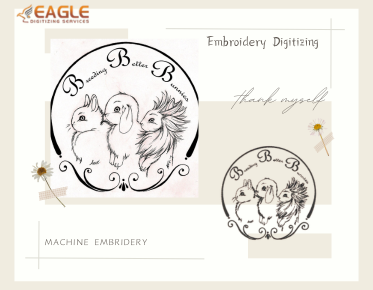Fabric Magic: Design Transfer for Embroidery/from Eagle Digitizing
Transferring a design onto fabric is a crucial step in the embroidery process. It’s where your creative vision begins to take shape. Whether you’re a seasoned embroiderer or a novice, mastering design transfer can elevate your projects from simple to spectacular. This process involves various techniques, each suited to different fabrics and design complexities. If this post spurred your interest and you want to find out more about Embroidery Digitizing, please feel free to contact us.
Why Transferring Your Design Matters
Properly transferring your design ensures precision and clarity in your final embroidery. A well-transferred design serves as a reliable guide, allowing you to focus on your stitching without worrying about losing your way. It sets the foundation for a successful project, making your embroidery experience more enjoyable and rewarding.
Preparing Your Design
Choosing the Right Design for Your Fabric
Selecting a design that complements your fabric is essential. Consider the fabric’s texture, weave, and color. Delicate fabrics like silk require finer, more intricate designs, while sturdy fabrics like cotton can handle bolder patterns. Ensure your design size fits well within your fabric’s dimensions, allowing enough space around the edges.
Scaling and Adjusting Your Design
Scaling your design to the appropriate size is crucial. Use software or photocopiers to enlarge or reduce the design. Adjusting elements within the design can also help fit it perfectly onto your chosen fabric. Ensure that any intricate details remain clear and not too small to stitch.
Printing Your Design: Tips and Tricks
When printing your design, use high-quality settings to ensure clarity. For intricate patterns, a laser printer often provides sharper lines. If using an inkjet printer, be cautious of ink bleeding, especially on fabric. Always print a test sheet first to check for any adjustments needed.
Tools and Materials Needed
Essential Supplies for Design Transfer
Gathering the right tools is the first step. You'll need your chosen design, transfer paper, fabric, an iron, and possibly a lightbox. Additionally, having a set of fine-tipped markers or pens can help in tracing more detailed designs.
Choosing the Right Transfer Medium
The transfer medium depends on your fabric and design complexity. Carbon paper is great for simplicity, while water-soluble stabilizers work well for more intricate designs. Test different mediums to see which provides the best results for your specific project.
Prepping Your Fabric for Transfer
Prepare your fabric by washing and ironing it. This removes any sizing or wrinkles that could interfere with the transfer process. Ensure the fabric is smooth and taut, as this will help achieve a cleaner transfer.
Traditional Transfer Methods
Using Carbon Paper: The Classic Way
Carbon paper is a tried-and-true method for transferring designs. Place the carbon paper between your design and fabric, then trace over the design with a stylus or pen. The pressure transfers the design onto the fabric, providing a clear outline to follow.
Tracing with a Lightbox
A lightbox is ideal for intricate designs. Place your design on the lightbox, then your fabric on top. The light shines through, making it easy to trace the design onto your fabric with a fine-tipped marker or pen. This method is precise and perfect for detailed work.
The Window Method: Simple and Effective
In the absence of a lightbox, a sunny window will suffice. Tape your design to the window, place the fabric over it, and trace the design. Natural light makes the lines visible through the fabric, providing an easy and effective transfer method.
Modern Transfer Techniques
Heat Transfer Pens and Pencils
Heat transfer pens and pencils are fantastic for detailed designs. Draw your design on transfer paper, then use an iron to transfer the ink onto your fabric. The heat activates the ink, ensuring a clean and precise transfer.
Iron-On Transfers: A Step-by-Step Guide
Iron-on transfers are user-friendly and efficient. Print your design on iron-on transfer paper, place it face down on the fabric, and press with a hot iron. The heat transfers the design onto the fabric, creating a clear and durable outline.
Printable Transfer Paper: How to Use It
Printable transfer paper allows you to print designs directly from your computer. Print your design, then iron it onto the fabric. This method is excellent for detailed and color designs, as it preserves the intricacies of the original artwork.
Specialty Transfer Methods
Water-Soluble Stabilizers
Water-soluble stabilizers are perfect for complex designs. Print or draw your design on the stabilizer, then adhere it to your fabric. Once you’ve completed your embroidery, the stabilizer dissolves in water, leaving only your beautiful stitching behind.
Sulky Sticky Fabri-Solvy: A Modern Solution
Sulky Sticky Fabri-Solvy is a peel-and-stick stabilizer that’s incredibly easy to use. Print your design on the Fabri-Solvy, stick it to your fabric, and stitch over it. Afterward, it dissolves in water, just like traditional water-soluble stabilizers.
Freezer Paper Method: For Precise Lines
The freezer paper method involves ironing freezer paper onto your fabric to create a temporary, stable surface. Draw or trace your design on the freezer paper, then peel it away once your transfer is complete. This method ensures precise lines without damaging the fabric.
Transferring Hand-Drawn Designs
Drawing Directly on Fabric: Tips for Success
Drawing directly on fabric can be risky but rewarding. Use fine-tipped, washable fabric markers for precision. Ensure your fabric is taut and smooth to avoid distortions. Practice on scrap fabric first to build confidence and refine your technique.
Using Water-Soluble Markers
Water-soluble markers are great for temporary designs. Draw your design directly on the fabric, then rinse away any remaining marks after you’ve completed your embroidery. These markers are ideal for quick, freehand designs.
Transferring with Tailor’s Chalk
Tailor’s chalk is a traditional tool for fabric marking. It’s perfect for bold designs on dark fabrics. Simply draw your design with the chalk, embroider, and then brush away any excess chalk. This method is easy and provides clear, temporary lines.
Digital Transfer Techniques
Using Embroidery Software for Design Transfer
Embroidery software allows for precise digital design transfer. Create or import your design, then use the software to convert it into a format your embroidery machine can read. This method is highly accurate and perfect for complex, multi-color designs.
Digital Printing on Fabric
Digital printing on fabric is a high-tech method that produces vivid, detailed designs. Use a specialized fabric printer to print your design directly onto the fabric. This technique is perfect for photorealistic designs and intricate patterns.
Laser Transfer: High-Tech Precision
Laser transfer uses laser printers and special transfer sheets to create sharp, detailed designs. Print your design, then use heat to transfer it onto the fabric. This method is precise and ideal for complex, high-resolution images.
Embroidery Hooping Techniques
How to Properly Hoop Your Fabric
Properly hooping your fabric is crucial for clean, even stitching. Place the inner hoop under the fabric, position the outer hoop on top, and tighten until the fabric is taut. Avoid overstretching to prevent distortions in your design.
Avoiding Common Hooping Mistakes
Common hooping mistakes include fabric slippage and over-tightening. Ensure the fabric is smooth and wrinkle-free before tightening the hoop. Check for even tension to avoid puckering or stretching.
Adjusting the Tension: Getting it Just Right
Adjusting the tension in your hoop ensures smooth, even stitching. The fabric should be tight enough to remain stable but not so tight that it distorts the weave. Practice on scrap fabric to find the perfect balance.
Fixing Transfer Mistakes
Erasing and Correcting Transfer Errors
Mistakes happen, but they can be fixed. Use a fabric eraser or damp cloth to remove transfer errors. For stubborn marks, rubbing alcohol can help. Always test removal methods on scrap fabric first to avoid damage.
Starting Over: When to Redo Your Transfer
Sometimes, starting over is the best option. If your design is misaligned or smudged, it’s better to redo the transfer than to proceed with a flawed guide. Take your time to ensure accuracy on the second attempt.
Preventing Smudges and Fades
To prevent smudges and fades, handle your fabric with clean, dry hands. Avoid excessive handling and keep the fabric flat. Use fixative sprays for some transfer methods to set the design before stitching.
Tips for Different Fabric Types
Transferring Designs onto Cotton
Cotton is versatile and easy to work with. Most transfer methods work well on cotton but ensure the fabric is pre-washed and ironed. This removes any sizing and ensures a smooth surface for transfer.
Silk and Satin: Special Considerations
Silk and satin require delicate handling. Use fine-tipped markers or pens and avoid methods that require excessive heat. Stabilizers can help keep the fabric stable during transfer and stitching.
Transferring onto Stretch Fabrics
Stretch fabrics need special care to avoid distortion. Use stabilizers to keep the fabric taut and prevent stretching. Choose transfer methods that don’t require much manipulation, such as water-soluble markers or stabilizers.
Adding Personal Touches
Customizing Your Design Before Transfer
Personalize your design by adding initials, dates, or custom elements. Use software to edit digital designs or draw directly on transfer mediums. Custom touches make your embroidery projects unique and meaningful.
Combining Multiple Transfer Methods
Combining methods can yield impressive results. Use a lightbox for intricate details and tailor’s chalk for bold outlines. Experiment with different combinations to find what works best for your design and fabric.
Adding Color Guides and Notes
Including color guides and notes in your transfer helps during stitching. Mark different sections with corresponding thread colors and add notes for stitch types or special instructions. This keeps your project organized and easy to follow.
Transferring Complex Designs
Breaking Down Large Designs into Sections
Large designs can be challenging. Break them down into manageable sections and transfer each part separately. Ensure alignment by using grid lines or reference points within the design.
Ensuring Alignment Across Sections
Alignment is key for large designs. Use a grid system or reference marks to keep sections aligned. Double-check measurements and placement before transferring each section to avoid misalignment.
Techniques for Multi-Color Transfers
For multi-color designs, use color-coded transfer sheets or mark color changes directly on the design. This helps keep track of different thread colors and ensures a cohesive final result.
Common Transfer Problems and Solutions
Dealing with Faint Transfers
Faint transfers can be frustrating. Enhance visibility by going over the lines with a fine-tipped marker or pen. Ensure your transfer method is suitable for the fabric to avoid faint results.
Preventing Ink Bleed on Fabric
Prevent ink bleed by choosing the right transfer medium and ink. Use light, even pressure during transfer, and avoid excessive handling. Test on scrap fabric to ensure the ink doesn’t bleed.
Ensuring Design Durability
Ensure durability by setting the design with heat or fixative sprays. Properly store and handle the fabric to avoid smudging. Durable designs withstand the embroidery process and remain clear until completion.
From traditional methods like carbon paper and lightboxes to modern techniques like digital printing and laser transfer, there’s a method for every embroiderer. Each method offers unique advantages and can be tailored to suit different projects and fabrics.
Experimentation is the key to learning what works best for you. Don’t be afraid to try new methods and combine techniques. Creativity in design transfer can lead to stunning, unique embroidery pieces.


